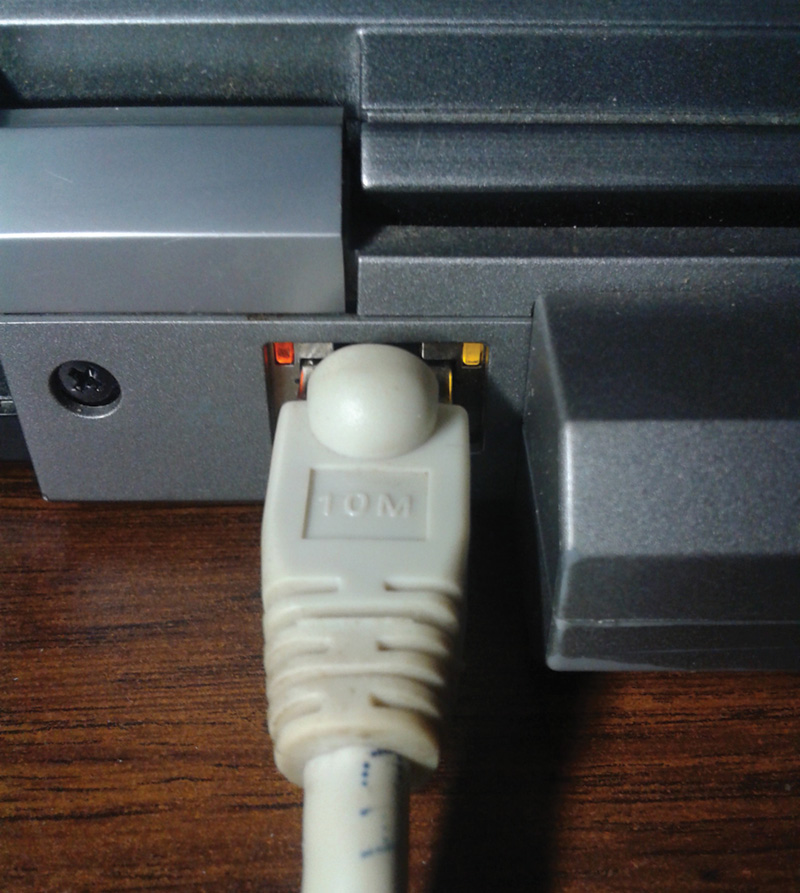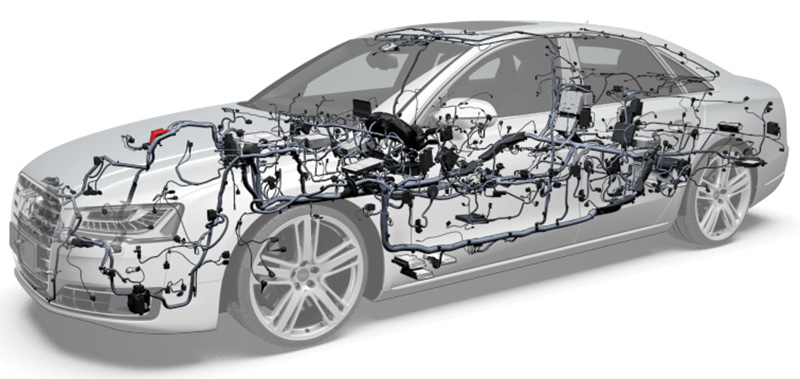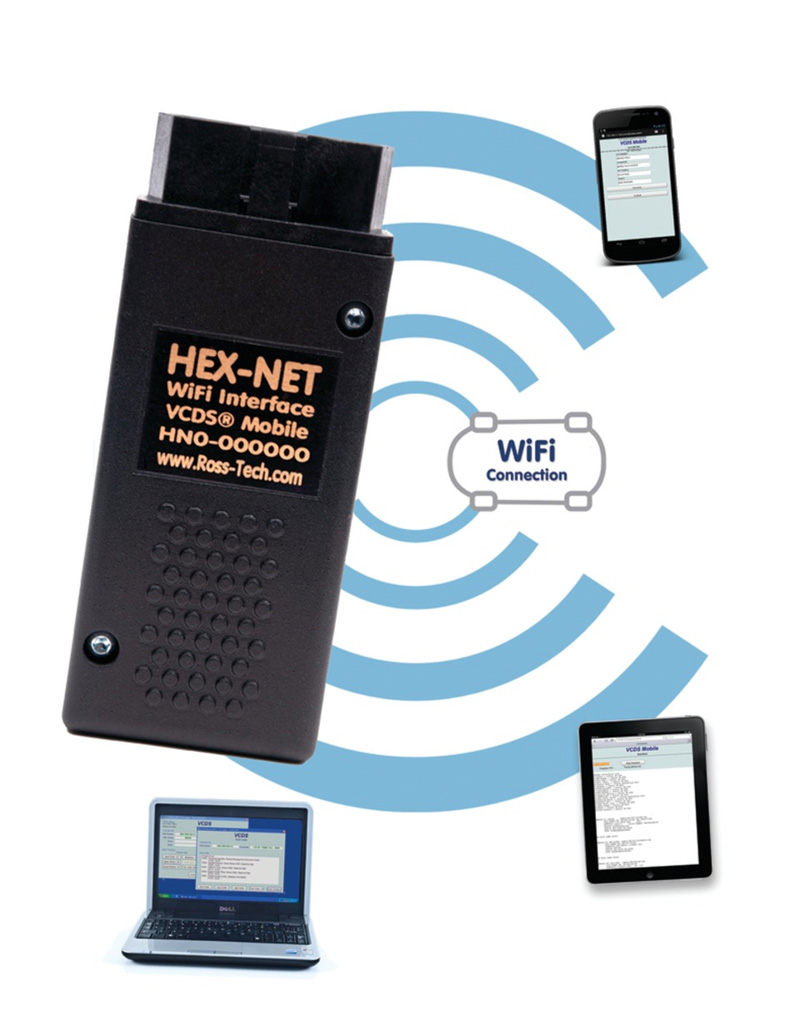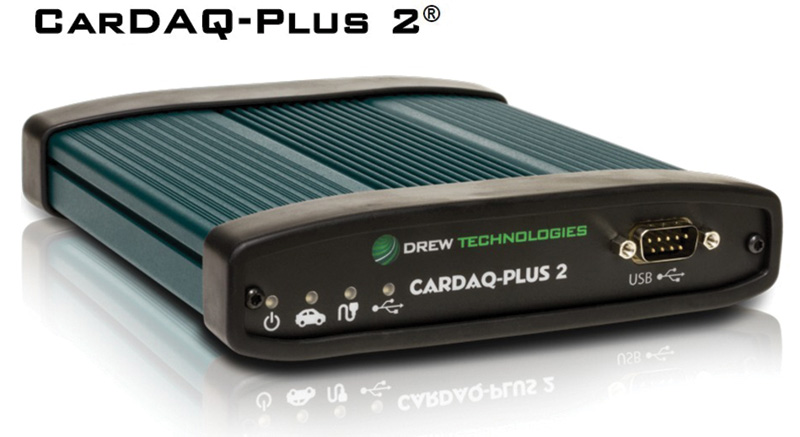The acronym DoIP is a simple short form for (Diagnostics over Internet Protocol) and will refer to the acronym from this point forward. DoIP is a new high speed diagnostic/data transfer standard for modern automotive applications. DoIP is a communication protocol for automotive onboard controllers (ISO standard 13400-2). DoIP serves as a transport protocol for Unified Diagnostic Services (UDS ISO 14229-1).
Ethernet is a long-standing relative of computer networking technologies, universally used in Local Area Networks (LAN).
LAN is a computer network that interconnects various computers within a restricted region. When trying to understand Ethernet and LAN, look at how a work, home or modern office network is connected. Look at the image on the previous page; is it familiar with the RJ-45 connector?
This specific connection illustrates a (CAT5) LAN cable connected to the rear of a diagnostic laptop. The opposite end is connected to a shop/office router.
Ethernet and LAN (Home and Office)
This image is of a real time connection to a router. This router also has WiFi functionality as well. Most modern routers have four or more LAN connections that will also connect four or more computers or printers. The difference between the LAN connection and a WiFi connection is SPEED!
(A) Ethernet connections (depending on the cable) can produce speeds anywhere from 100 Mbps to 1000 Mbps and beyond.
(B) WiFi connections (depending on the frequency and distance) can produce anywhere from speeds of 20 Mbps or more.
All of A and B network speeds will depend on the current equipment and the network load of users and applications.
An introduction to DoIP
The CAN bus system with MOST, LIN and FlexRay have become well established within the automotive industry. Currently, CAN bus and the above noted systems will continue to be used within automotive networks, technologies and architectures well into the future. That being said, LAN connections solve many problems with speed and security with modern Driver Assistance Systems.
The DoIP protocol has several functions built into the system that allows multiple controllers to be interrogated and be managed. This will also include any other communications system such as CAN, MOST, LIN and FlexRay (depending on installed equipment). From the visual standpoint of a technician, you may not even notice how a communications session takes place. The issues surface when these systems are not understood or how they behave. DoIP will also be central in flash updates and perform much faster because of the ability of the Ethernet structure to program multiple controllers in parallel.
DoIP with a connected Ethernet system has the function and ability to: send, warn, apply, adapt, intervene, authenticate and secure information with all installed Driver Assistance Systems. Some Driver Assistance Systems will include front facing and rear facing cameras, Adaptive Cruise Control, Side Assist, Lane Change Assist, Park Assist and many other systems.
Note: Refer to the last issue for descriptions of these systems.
The DLC for these vehicles will look the same but the structure of the communications protocol will be different. Additionally, tools and equipment will also change. The day of your “so and so†scan tool has come to an end. Embrace this protocol sooner rather than later.
Is there a future to the future?
As in an example, Molex and BlackBerry have teamed up on the development of a 10 Gbps Ethernet Automotive Networking platform. These are among many companies pulling together resources for this high speed creation but interestingly, what if the 10 Gbps Ethernet Automotive Network features secure over-the-air software and firmware updates? In future articles, many more examples will come forward.
What if that DoIP design was enabled to help avoid the need for vehicle recalls and updates? What if enabling in-vehicle security with DoIP requires an on-line subscription and an expensive way to “go for a road test?â€
So how many tools are available? (These are common examples).
Ross-Tech VCDS comes to mind as a versatile tool that works great off-line and has many features built in for recording data in an Excel format. Added applications such as “screen recording†for playback are just as important. This is not a pass-through tool.
DrewTech CarDAQ Plus 2 is a J2534 device that will handle DoIP now and into the future. This tool can be used with ODIS and capable of “flash programming.†This tool is Bluetooth ready.
The VAS 6154 or VAS 6154/7 tool from I+ME ACTIA GmbH is the factory based tool and is also capable of “flash programming.†The VCI comes with USB and WiFi, and a LAN connection can be ordered.
The “softing†Company has been developing applications and hardware that will offer the modern technician simple but powerful MCU based controllers.
This VCDS tool provides many options for live data that can be connected via USB. The HEX-NET interface can also communicate via WiFi to a laptop or table/smart phone.
Modern J2534 devices that are equipped with DoIP will be the default tool for these modern vehicles. One manufacturer is Drew Technologies, the device being the CarDAQ Plus 2. New versions can connect to the laptop via Bluetooth.
Another option is a factory based tool. The VAS 6154 can use the USB connection but also features a WiFi direct connection and/or infrastructure connection. Updated VCI’s can include the RJ-45 connection (VAS 6154/7).
VIN | ING 2000 from softing is a high quality multibus VCI that will connect via WLAN, LAN and USB. The device can handle 2 x K/L Line ISO 9141/2, 2 x CAN V2.0B high-speed, Ethernet for DoIP and D-PDU API software. When engaged in the world of DoIP, this will be another future-proof solution to access the speed requirements of Ethernet. This device offers a magnetic style fastener for USB and LAN.
Connectivity and subscriptions
With the advent of on-line subscriptions, be very aware of cloned equipment and what the costs may be. Be aware of the investment in tools and how the facility expects their equipment to behave. Copy or cloned tools are often used, but as the manufacturers’ portals become more sophisticated, these clones will NOT work. The manufacturer portals will only recognize the “registered†equipment or an approved pass-through tool.
The expectations of modern diagnostics.
- The architecture of all on-line or off-line diagnostic equipment must have direct access to all Ethernet control units (nodes).
- There must be NO traffic jams to reduce the resource needs of the DoIP gateways.
- All Ethernet controllers are DoIP nodes or DoIP gateways and can be diagnosed via DoIP without the need of a central DoIP gateway.
- All off-line or on-line diagnostic equipment has to manage multiple TCP/IP connections.
- Proprietary protocols are not necessary.
- Security mechanisms must be in place on each DoIP Node and DoIP Gateway.
- Full Ethernet bandwidth must be available and also includes controller flashing.
- Full Ethernet bandwidth is expected to simultaneously parallel flash.
So why the first image? Why a quick lesson on Ethernet?
Because “There’s a “New Kid in Town†– The Eagles.
Knowledge about these new systems, how they interact with the modern technician and the repair facility will be just a test.
|
Question 1: |
|
Answer: Further discussion is required. |











0 Comments